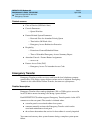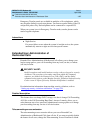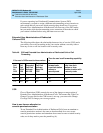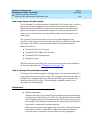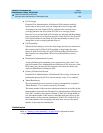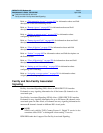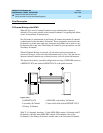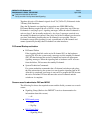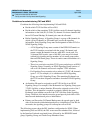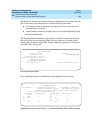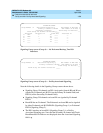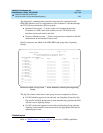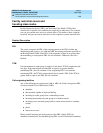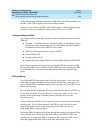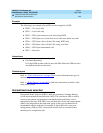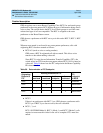
DEFINITY ECS Release 8.2
Administrator’s Guide
555-233-506
Issue 1
April 2000
Features and technical reference
1334Facility and Non-Facility Associated Signaling
20
Guidelines for administering FAS and NFAS
Coordinate the following when implementing FAS and NFAS:
■ Decide which T1/E1 facilities will use FAS.
■ Decide which of the remaining T1/E1 facilities carries D-channel signaling
information on the 16th (E1) or 24th (T1) channel. For those channels that
have a D-Channel Backup, D-channel pairs must be allocated.
■ Define Signaling Groups. A Signaling Group is a group of B-channels for
which a given D-channel (or D-channel pair) carries the signaling
information. Each Signaling Group must be designated as either a FAS or
NFAS Signaling Group.
— A FAS Signaling Group must contain all the ISDN B-Channels on
the T1/E1 interface associated with the group’s D-channel, and
cannot contain B-channels from any other DS1 circuit pack. For
24-channel DS1 boards, some of the DS1 ports may use in-band
(robbed-bit) signaling and be members in a tie trunk group rather
than an ISDN trunk group. These tie trunks cannot be members of a
Signaling Group.
— There is no restriction on which T1/E1 ports can belong to an NFAS
Signaling Group. Normally, an NFAS Signaling Group consists of
one or two D-channels and several complete T1/E1 interfaces.
— If a Signaling Group contains only a subset of a T1/E1’s B-channels
(ports 1–12, for example), it is considered an NFAS Signaling
Group, not a FAS Signaling Group. The remaining B-channels on
the T1/E1 are then assigned as members of another NFAS Signaling
Group.
■ An Interface ID must be assigned to each T1/E1 facility in an NFAS
Signaling Group. For example, if the B-channels in a Signaling Group span
3 T1/E1 facilities, a unique Interface ID must be assigned to each of the 3
facilities. This designation is required to uniquely identify the same
B-channel (port) number on each of the T1/E1 facilities in the Signaling
Group. Therefore, this interface must be agreed upon by both sides of the
interface and administered prior to initialization.
■ Primary and Secondary D-Channel Backup must be agreed upon by both
sides of the interface and administered prior to initialization. If the IDs do
not match, the signaling group will come up but calls will fail.
The following screens show the DS1 interface configuration for NFAS. When
implementing FAS and NFAS, the DS1 screen must be submitted first, followed
by the Interface Link and associated forms, followed by the ISDN-PRI trunk
group, Signaling Group, and Trunk Group Members forms.



